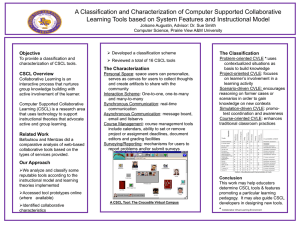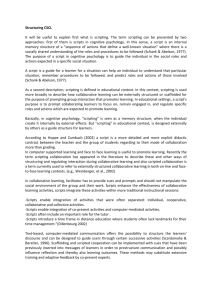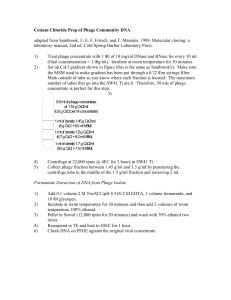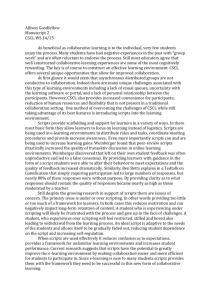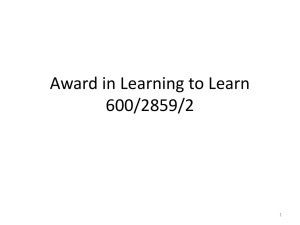Motivation and Emotions in CSCL
advertisement
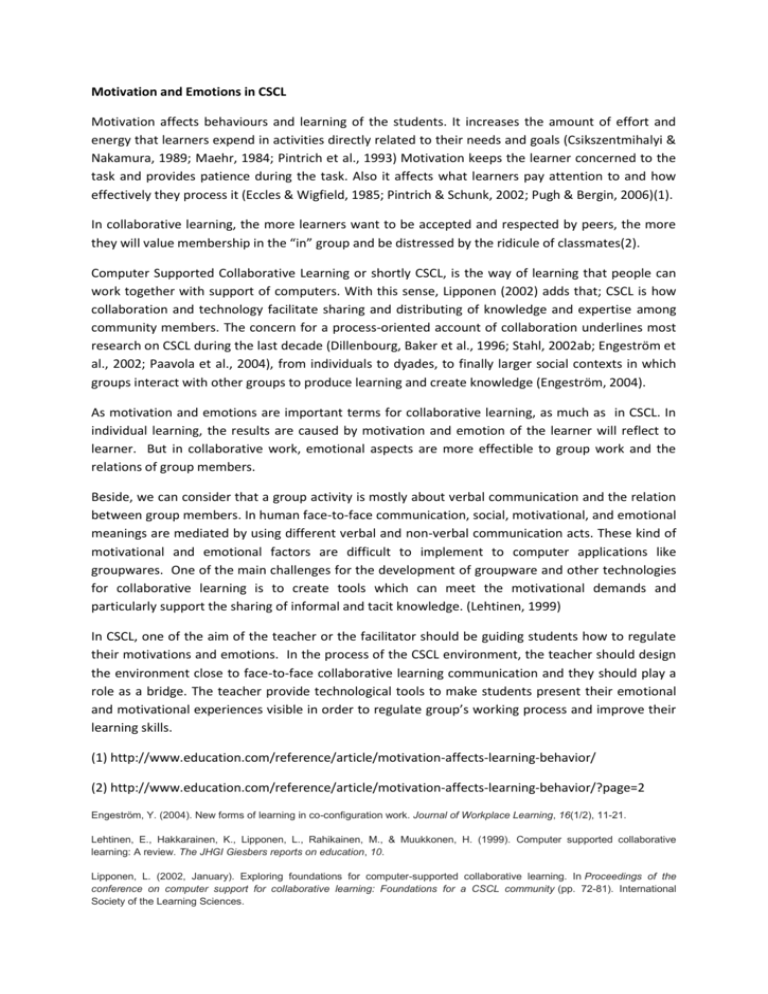
Motivation and Emotions in CSCL Motivation affects behaviours and learning of the students. It increases the amount of effort and energy that learners expend in activities directly related to their needs and goals (Csikszentmihalyi & Nakamura, 1989; Maehr, 1984; Pintrich et al., 1993) Motivation keeps the learner concerned to the task and provides patience during the task. Also it affects what learners pay attention to and how effectively they process it (Eccles & Wigfield, 1985; Pintrich & Schunk, 2002; Pugh & Bergin, 2006)(1). In collaborative learning, the more learners want to be accepted and respected by peers, the more they will value membership in the “in” group and be distressed by the ridicule of classmates(2). Computer Supported Collaborative Learning or shortly CSCL, is the way of learning that people can work together with support of computers. With this sense, Lipponen (2002) adds that; CSCL is how collaboration and technology facilitate sharing and distributing of knowledge and expertise among community members. The concern for a process-oriented account of collaboration underlines most research on CSCL during the last decade (Dillenbourg, Baker et al., 1996; Stahl, 2002ab; Engeström et al., 2002; Paavola et al., 2004), from individuals to dyades, to finally larger social contexts in which groups interact with other groups to produce learning and create knowledge (Engeström, 2004). As motivation and emotions are important terms for collaborative learning, as much as in CSCL. In individual learning, the results are caused by motivation and emotion of the learner will reflect to learner. But in collaborative work, emotional aspects are more effectible to group work and the relations of group members. Beside, we can consider that a group activity is mostly about verbal communication and the relation between group members. In human face-to-face communication, social, motivational, and emotional meanings are mediated by using different verbal and non-verbal communication acts. These kind of motivational and emotional factors are difficult to implement to computer applications like groupwares. One of the main challenges for the development of groupware and other technologies for collaborative learning is to create tools which can meet the motivational demands and particularly support the sharing of informal and tacit knowledge. (Lehtinen, 1999) In CSCL, one of the aim of the teacher or the facilitator should be guiding students how to regulate their motivations and emotions. In the process of the CSCL environment, the teacher should design the environment close to face-to-face collaborative learning communication and they should play a role as a bridge. The teacher provide technological tools to make students present their emotional and motivational experiences visible in order to regulate group’s working process and improve their learning skills. (1) http://www.education.com/reference/article/motivation-affects-learning-behavior/ (2) http://www.education.com/reference/article/motivation-affects-learning-behavior/?page=2 Engeström, Y. (2004). New forms of learning in co-configuration work. Journal of Workplace Learning, 16(1/2), 11-21. Lehtinen, E., Hakkarainen, K., Lipponen, L., Rahikainen, M., & Muukkonen, H. (1999). Computer supported collaborative learning: A review. The JHGI Giesbers reports on education, 10. Lipponen, L. (2002, January). Exploring foundations for computer-supported collaborative learning. In Proceedings of the conference on computer support for collaborative learning: Foundations for a CSCL community (pp. 72-81). International Society of the Learning Sciences. Schiefele, U., & Csikszentmihalyi, M. (1995). Motivation and ability as factors in mathematics experience and achievement. Journal for research in mathematics education, 163-181.
